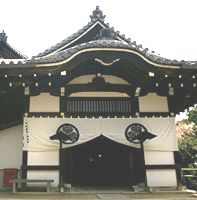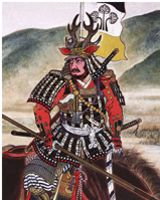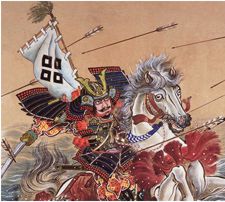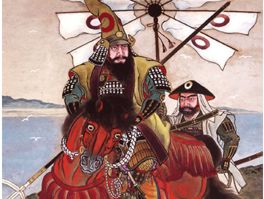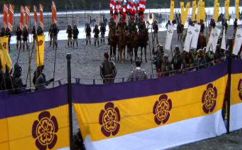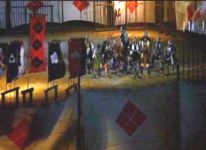| CRESTS OF JAPANESE WARLORDS' CLANS 3 |
| PAGE 1 | PAGE 2 | PAGE 3 | PAGE 4 |
Some warlords got their second and third crests not via family ties, but through wars. If a warlord liked the crest of the enemy that he had exterminated, he could use the crest. He might also take the crest just like a trophy -- so that other warlords would know he was the victor of such and such battles against so and so. Some others got their second crest (or got rid of their original crest for the crest gotten later) as gifts. A lord could give a license to his Generals and vassals, just like Shoguns, Chancellor, Regents and overlords could receive crests from the Emperor.
Yet, the accidentality of life, as you would instantly observe in the realm of invention and discovery (Scott and Amundsen both went and perished at the pole at the same time without ever knowing each other before; 'everybody' discovered America, and so on), played in the warring Japan, too. So, even when there was no biz whatsoever among them, some samurai family crests still managed to look similar with each other. Look closer at the coats of arms of the Oda clan, overlord of Central Japan; crest of their equivalence in the Kyushu isles, the overlord of 9 provinces, the Omura clan; crest of Omura's fellow Christian warlord Arima, and the 'neutral' clan of Onodera:
Here are a few more clots of samples, among the famous Asano clan's crest, the Christian warlord Otani's and the Buddhist Aso's; Obu's crest and the one that belonged to another Christian samurai clan, Ito.
The same happened between the coats of arms that belonged to the clans of Murakami and Kurushima, also Kono and Inaba. While between the crests of the Shimizu and Nagao families there is a resemblance.
The crests of the Matsuura clan and a resilient samurai clan that accidentally splashed worldwide through Takita Yojiro's movie Onmyoji, the Abe, referred to a similar thing; so were the crest of the inimitable Hachisuka clan and the Suda -- though what they both took up as family crests was a 'universal' Buddhist symbol twisted irrepairably in 20th century by you-know-who.
And the 'modern' and 'post-modern' crests belonging to the well-known warriors of the clans of Hori, Sassa, So, and the much greater Amako shared something among them, as well as the crests of the Suganuma, Shoni and Kamei, and even the lamentable Miyoshi (as far as Oda Nobunaga was concerned).
The same is observable among the coats of arms belonging to the families of the illustrious Kikkawa and the legendary Baba, as well as the Yui, Narita, Katsumoto and Jinbo:
Plus the crests of Sakuma, Yamana, Nakajo, Miura, Ina and Kobayakawa:
Most warlords only gave a part of their crests, or their crests were used as an exalted part of their Generals' own crests by their own initiative (like Oda crest in Takigawa's). Oda Nobunaga didn't mind such a tribute (for it was a tribute). Tokugawa Ieyasu was also okay that his clan's crest was modified to be Honda's second (and, after the license was given, the default) family crest.
But Date Masamune, among several of his kind, killed his own vassal whose crest was too much like his own clan's. Toyotomi Hideyoshi was similarly inclined, so nobody dared to make any crest that looked like his clan's. Thus medieval Japanese battlefields were as rainbowly-decorated as a festival every time around, while it got harder to be a soldier by then -- you would have to remember to whom all of those crests belonged.
Click on to the next page for more crests, intricate and simple, that are nonetheless sort of non-copious; and the personal battle-banners of the big shots among the Japanese 'Warring States' samurai chiefs of the clans. |
| Samurai Crests 2 | Flowers | Next Crests |
|
Site & Rap © 1996, 1997, 1998, 1999, 2000, 2001, 2002, 2003, 2004, 2005, 2006 Nina Wilhemina
All rights reserved. Every borrowed image at this site is put for non-profit educational purposes only.
HOME
 LINKS
LINKS
 CONTACT
CONTACT
 CREDITS
CREDITS
 COMMENTS
COMMENTS
Sources tapped for this page: Nihon Shakai no Kazoku teki Kosei (Tokyo: 1948); Kono Shozo, Kokumin Dotoku Yoron (Tokyo: 1935); Anesaki Masaharu, Nichiren, the Buddhist Prophet (Cambridge, Mass.: Harvard University Press, 1916); Robert Cornell Armstrong, Light from the East, Studies of Japanese Confucianism (University of Toronto, Canada, 1914); Sasama Yoshihiko, Nihon kassen zuten (Yuzankaku, 1997); William Aston, Shinto: The Way of the Gods (London: Longmans, Green, 1905); Ruth Benedict, The Chrysanthemum and the Sword (Boston: Houghton Mifflin, 1946); Charles Eliot, Japanese Buddhism (London, 1935); Futaki Kenichi, Chuusei buke no saho (Yoshikawa Kobunkan, 1999); Kiyooka Eichii, The Autobiography of Fukuzawa Yukichi (Tokyo, Hokuseido Press, 1934); Konno Nobuo, Kamakura bushi monogatari (Kawade shobo shinsha, 1997); Nukariya Kaiten, The Religion of the Samurai (London: Luzac, 1913); A.L. Sadler, The Beginner's Book of Bushido by Daidoji Yuzan (Tokyo: Kokusai Bunka Shinkokai, 1941); A.L. Sadler, The Makers of Modern Japan (Tokyo: Tuttle, 1978); Satomi Kishio, Nichirenism and the Japanese National Principles (NY: Dutton, 1924); Suzuki D.T., Zen Buddhism and Its Influence on Japanese Culture (Kyoto: The Eastern Buddhist Society, 1938); Henri Van Straelen, Yoshida Shoin (Leiden: Brill, 1952); Robert Bellah, Tokugawa Religion; Sato Hiroaki, Legends of the Samurai (Overlook Press, 1995); Masaaki Takahashi, Bushi no seiritsu: Bushizo no soshutsu (Tokyo: Tokyo daigaku, 1999); Stephen Turnbull, Samurai Warlords (London: Blandford Publishing, 1992); Paul Akamatsu, Meiji 1868, Revolution and Counter-Revolution (Allen & Unwin, 1972); Nitobe Inazo, Bushido, The Soul of Japan (Tokyo: Tuttle, 1970); Paul Varley and Ivan Morris, The Samurai (Weidenfeld, 1970); Inoguchi and Nakajima, The Divine Wind: Japanese Kamikaze Force in World War II (Hutchinson, 1959), Seki Yukihiko, Bushi no tanjo (Tokyo: NHK, 2000); Amino Yoshihiko, ed. Edojidai no mikataga kawaruho (Tokyo: Yosensha, 1998). |

